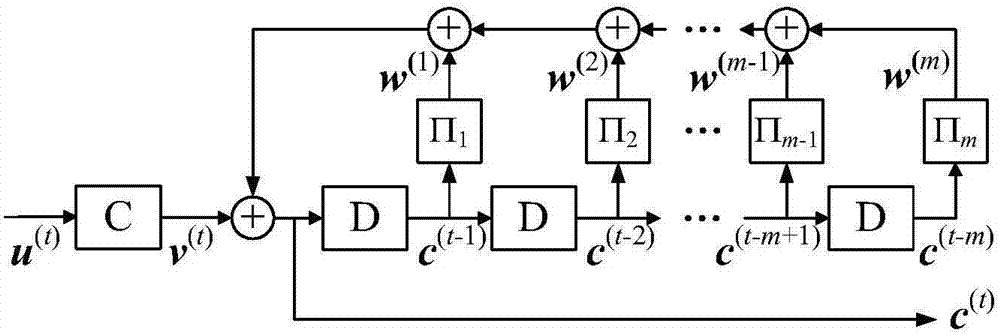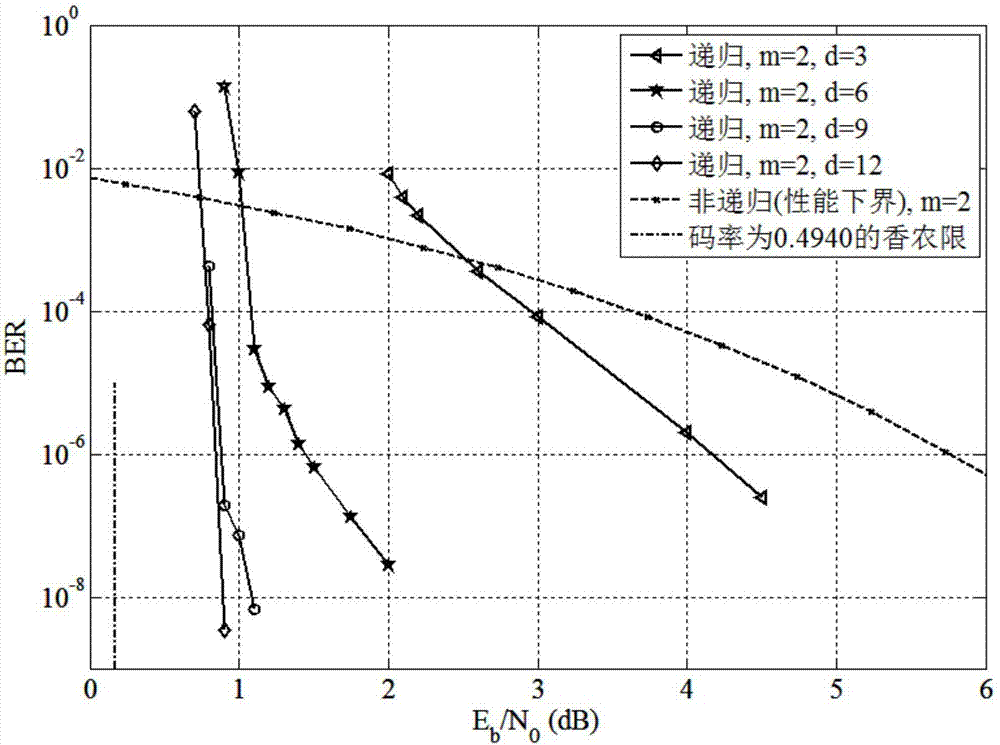Recursive block Markov superimposed encoding method
A superimposed coding, recursive technology, applied in the direction of error correction/detection using convolutional codes, data representation error detection/correction, etc., can solve the problem of high decoding complexity
- Summary
- Abstract
- Description
- Claims
- Application Information
AI Technical Summary
Problems solved by technology
Method used
Image
Examples
Embodiment 1
[0037] Reference figure 1 , A binary information sequence of length K=kBL=1×5000×988 u Divided into L=988 equal length groups u =( u (0) , u (1) ,..., u (987) ), the length of each packet is kB=5000. The basic code encoder C uses a repetitive code with code length n=2 and information bit length k=1. In this example, the code memory length is m=2, and two random interleavers are used. The symbol-by-symbol aliaser S uses a bit-by-bit binary domain sum operator. The ending length T is set to be the same as the decoding delay d, that is, T=d. Reference figure 1 , Its encoding method includes the following steps:
[0038] Step one, put the information sequence u Divided into 988 equal length groups u =( u (0) , u (1) ,..., u (987) ), the length of each packet is 5000; for t=-1, -2, the sequence of length nB=10000 c (t) The initial setting is a sequence of all zeros, that is c (t) = 0 ;
[0039] Step 2: At t=0,1,...987, change the sequence of length kB=5000 Send it to the basic cod...
Embodiment 2
[0050] Reference figure 1 , A binary information sequence of length K=kBL=1×5000×988 u Divided into L=988 equal length groups u =( u (0) , u (1) ,..., u (987) ), the length of each packet is kB=5000. The basic code encoder C uses a repetitive code with code length n=2 and information bit length k=1. In this example, the code memory length m=3, and three random interleavers are used. The symbol-by-symbol aliaser S uses a bit-by-bit binary domain sum operator. The ending length T is set to be the same as the decoding delay d, that is, T=d. Reference figure 1 , Its encoding method includes the following steps:
[0051] Step one, put the information sequence u Divided into 988 equal length groups u =( u (0) , u (1) ,..., u (987) ), the length of each packet is 5000; for t=-1, -2, -3, the sequence of length nB=10000 c (t) The initial setting is a sequence of all zeros, that is c (t) = 0 ;
[0052] Step 2: At t=0,1,...987, change the sequence of length kB=5000 Send it to the basic ...
PUM
 Login to View More
Login to View More Abstract
Description
Claims
Application Information
 Login to View More
Login to View More - R&D
- Intellectual Property
- Life Sciences
- Materials
- Tech Scout
- Unparalleled Data Quality
- Higher Quality Content
- 60% Fewer Hallucinations
Browse by: Latest US Patents, China's latest patents, Technical Efficacy Thesaurus, Application Domain, Technology Topic, Popular Technical Reports.
© 2025 PatSnap. All rights reserved.Legal|Privacy policy|Modern Slavery Act Transparency Statement|Sitemap|About US| Contact US: help@patsnap.com



